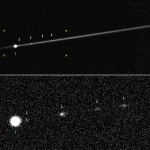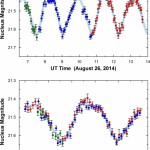W. M Keck Observatory press release…
A team led by astronomers from the Jagiellonian University in Krakow, Poland, recently used the W. M. Keck Observatory in Hawaii to observe and measure a rare class of “active asteroids” that spontaneously emit dust and have been confounding scientists for years. The team was able to measure the rotational speed of one of these objects, suggesting the asteroid spun so fast it burst, ejecting dust and newly discovered fragments in a trail behind it. The findings are being published in Astrophysical Journal Letters on March 20, 2015.

Then in 2010 a new type of active asteroid was discovered, which ejected dust like a shot without an obvious reason. Scientist gravitated around two possible hypotheses. One states the explosion is a result of a hypervelocity collision with another minor object. The second popular explanation describes it as a consequence of “rotational disruption”, a process of launching dust and fragments by spinning so fast, the large centrifugal forces produced exceed the object’s own gravity, causing it to break apart. Rotational disruption is the expected final state of what is called the YORP effect – a slow evolution of the rotation rate due to asymmetric emission of heat.
To date, astronomers have identified four objects suspected of either collision- or rotation-driven activity. These four freakish asteroids are all very small, at a kilometer or less, which makes them unimaginably faint when viewed from a typical distance of a couple hundred million miles. Despite prior attempts, the tiny size of the objects kept scientists from determining some of the key characteristics that could prove or disprove the theories.
Until last August, when the team led by Michal Drahus of the Jagiellonian University was awarded time at Keck Observatory.
“When we pointed Keck II at P/2012 F5 last August, we hoped to measure how fast it rotated and check whether it had sizable fragments. And the data showed us all that,” Drahus said.
The team discovered at least four fragments of the object, previously established to have impulsively ejected dust in mid-2011. They also measured a very short rotation period of 3.24 hours – fast enough to cause the object impulsively explode.
“This is really cool because fast rotation has been suspected of catapulting dust and triggering fragmentation of some active asteroids and comets. But up until now we couldn’t fully test this hypothesis as we didn’t know how fast fragmented objects rotate,” Drahus said.

“This is a well-established technique but its application on faint targets is challenging,” said Waclaw Waniak of the Jagiellonian University who processed the Keck Observatory data. “The main difficulty is the brightness must to be probed every few minutes so we don’t have time for long exposures. We needed the huge collecting area of Keck II, which captures a plentiful amount of photons in a very short time.”
The photons were then concentrated in the telescope’s light path and sent to the DEIMOS instrument to produce the data that allowed the scientists to determine P/2012 F5’s nature. While monitoring brightness in the individual 3-minute exposures, scientists also compiled all the data to produce a single ultra-deep image, which revealed the fragments.
The success wouldn’t be possible if the selected target, P/2012 F5, were not an ideal candidate for this study. Alex R. Gibbs discovered the object on March 22, 2012 with the Mount Lemmon 1.5 meter reflector. It was initially classified as a comet, based solely on its “dusty” look. But two independent teams quickly have shown all this dust was emitted in a single pulse about a year before the discovery – something that doesn’t happen to comets. When the dust settled in 2013, another team using the University of Hawaii’s 2.2-meter telescope on Mauna Kea detected a star-like nucleus and suggested a maximum size of 2 kilometers.
“We suspected that this upper limit was close to the actual size of the object. Consequently, we chose to observe P/2012 F5 because – despite its small size – it appeared to be the largest and easiest to observe active asteroid suspected of rotational disruption,” said Jessica Agarwal of the Max Planck Institute for Solar System Research who chose P/2012 F5 as the subject.
As a result of the study, P/2012 F5 is the first freshly fragmented object in the solar system with a well-determined spin rate, and this spin rate turns out to be the fastest among the active asteroids. A careful analysis made by the team shows that these two features of the object are consistent with the “rotational disruption” scenario. But alternative explanations, such as fragmentation due to an impact, cannot be completely ruled out.
“There are many faster rotators among asteroids which don’t show signs of a recent mass loss. And there are many hypervelocity impactors straying out there and looking for targets to hit – be it a fast or slow rotator,” Drahus said.
“We’re indebted to the Caltech Optical Observatories for generously awarding Keck Observatory time for this program,” said Drahus – formerly a NRAO Jansky Fellow at Caltech. “Without the huge collecting area of Keck II’s 10-meter mirror, we wouldn’t be able to achieve our goals so swiftly.”


Great article. It shows Kecks ability to do many types of science. Its nice to see time allocated for
inshore so to speak science
aloha